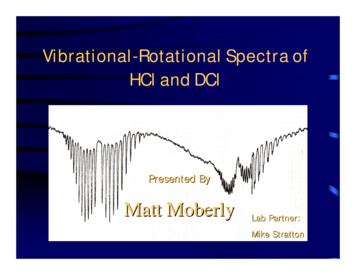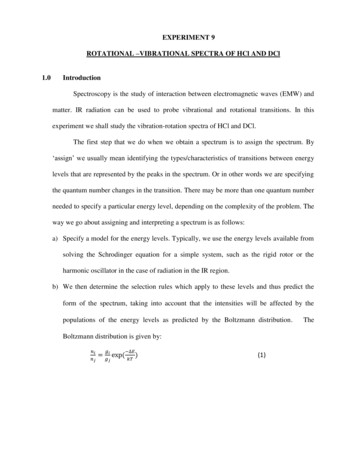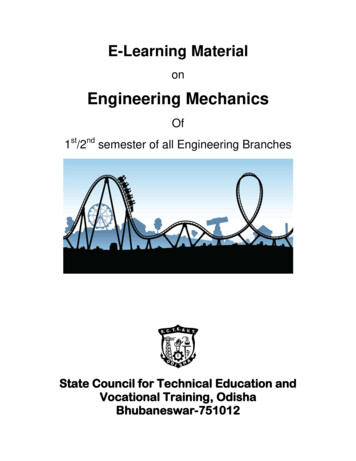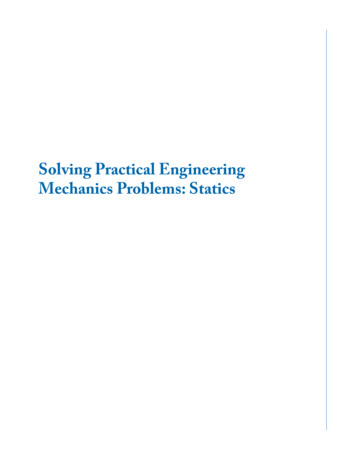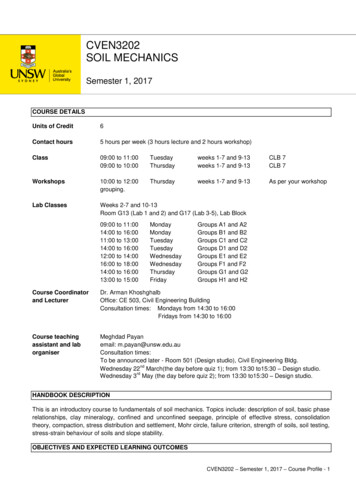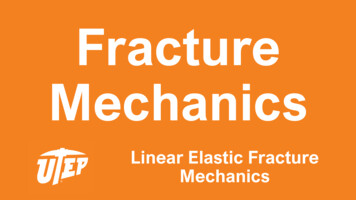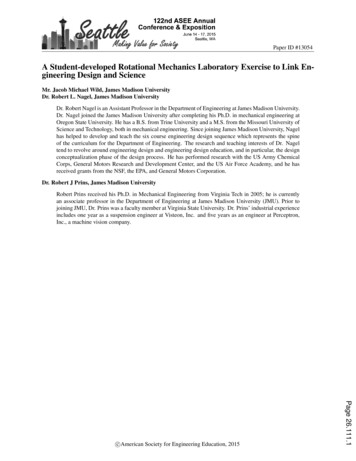
Transcription
Paper ID #13054A Student-developed Rotational Mechanics Laboratory Exercise to Link Engineering Design and ScienceMr. Jacob Michael Wild, James Madison UniversityDr. Robert L. Nagel, James Madison UniversityDr. Robert Nagel is an Assistant Professor in the Department of Engineering at James Madison University.Dr. Nagel joined the James Madison University after completing his Ph.D. in mechanical engineering atOregon State University. He has a B.S. from Trine University and a M.S. from the Missouri University ofScience and Technology, both in mechanical engineering. Since joining James Madison University, Nagelhas helped to develop and teach the six course engineering design sequence which represents the spineof the curriculum for the Department of Engineering. The research and teaching interests of Dr. Nageltend to revolve around engineering design and engineering design education, and in particular, the designconceptualization phase of the design process. He has performed research with the US Army ChemicalCorps, General Motors Research and Development Center, and the US Air Force Academy, and he hasreceived grants from the NSF, the EPA, and General Motors Corporation.Dr. Robert J Prins, James Madison UniversityRobert Prins received his Ph.D. in Mechanical Engineering from Virginia Tech in 2005; he is currentlyan associate professor in the Department of Engineering at James Madison University (JMU). Prior tojoining JMU, Dr. Prins was a faculty member at Virginia State University. Dr. Prins’ industrial experienceincludes one year as a suspension engineer at Visteon, Inc. and five years as an engineer at Perceptron,Inc., a machine vision company.Page 26.111.1c American Society for Engineering Education, 2015
A Student-developed Rotational Mechanics Laboratory Exerciseto Link Engineering Design and ScienceIntroductionA noted challenge in our curriculum when teaching engineering design or engineering science isa reluctance by students to apply topics learned in their engineering science courses in theirengineering design courses and vice versa. This paper reports on the first step—design anddevelopment of a rotational mechanics laboratory exercise—toward creating shared experiencesthat scaffold student learning through deliberate and topically-meaningful activities sharedbetween engineering design and engineering science courses typically completed by sophomoreengineering students in our program.In order to provide context for the rotational mechanics laboratory exercise, we offer thefollowing brief descriptions of the university, program, and courses that the exercise targets.James Madison UniversityJames Madison University (JMU) is a public regional university located in Harrisonburg,Virginia, within the Shenandoah Valley. James Madison University has a total enrollment ofapproximately 20,000 students across all of its seven colleges with approximately 1,700 of thosestudents enrolled in a graduate program. The College of Integrated Science and Engineering(CISE) was established in 2012 with a college restructuring and consists of three academicdepartments: Integrated Science and Technology, Computer Science, and Engineering.Madison EngineeringThe School of Engineering at JMU was founded in 2005 with the first cohort of students startingin fall of 2008.1 The School of Engineering now exists as the Department of Engineering (orcolloquially, as Madison Engineering).Madison Engineering was designed to be a progressive program unrestricted by the boundariesof traditional engineering disciplines. The program was proposed based on the followingdescription of the Engineer of 2020 by the National Academy of Engineering: one whopossesses strong analytical skills, strong communication skills, a strong sense of professionalism,creativity, and versatility.2,3 The program is ABET accredited (10/01/2011 – present) under theEngineering Accreditation Commission. The program is not discipline specific and has a currentenrollment of approximately 450 students as of August 2014. The program is comprised of 126credit hours with most students completing the degree in four years.Page 26.111.2The Madison Engineering program was established to train the engineering versatilist.Engineering versatilist is a phrase invented by Garner, Inc. and popularized by Friedman thatdescribed an individual who can “apply depth of skill to a progressively widening scope ofsituations and experiences, gaining new competences, building relationships, and assuming newroles.” 4 The program includes a design focus where design is a thread that runs through thecurriculum at all academic levels.5
Courses Affected by Rotational Mechanics Laboratory ExerciseDuring the spring semester of their sophomore year, Madison Engineering students typically takea statics and dynamics combined course and a design course (Engineering Design 2). Statics &Dynamics introduces applied mechanics from an engineering standpoint and is the first of fiverequired "engineering science" courses in the curriculum. The statics and dynamics course hasthree class meetings each week and one lab meeting each week. Course labs have been designedto pair with course classroom content and involve activities such as learning to take forcemeasurements with load cells. Engineering Design 2 is the second design course in a two coursesequence (Engineering Design 1 and Engineering Design 2) and introduces students to processbased design in preparation for their capstone sequence.6-10 For the past five years and for theforeseeable future, Engineering Design 1 and 2 have focused on the development of a humanpowered vehicle for a client. Each year’s client has had a physical condition that makesoperation of a traditional bicycle difficult or impossible. In the first semester of the designcourse sequence, students are grouped in teams to determine the client's needs and formulatedesigns to meet the needs. In the second semester, the student teams work to assess theirconceptual designs and to construct physical prototypes. This design and construction activityprovides the students with a yearlong, immersive experience with a client and a mechanicalapparatus.Motivation & BackgroundEngineering science courses typically include applications and examples that are taken from the"real world". For example, typical problems found in statics and dynamics textbooks introducestudents to abstractions for and analysis of devices in common usage including cranes,helicopters, conveyors, and bolt cutters.11-13 White found, though, that students, when solvingbasic physics problems, often draw from “diverse components of their knowledge, which seemrelevant to the solution of force and motion problems, but which often have properties thatconflict with the implications of Newton’s laws of motion.” 14 Caramazza et al. found similarwith a study of undergraduate physics students at Johns Hopkins University,15 and many similarexamples can be found in literature. These findings indicate that students’ mental models (wheremental model is defined as “a representation that is isomorphic to the physical situation that itrepresents and the inference processes the physical processes being reasoned about” 16) of suchdevices may tend to be poorly developed, lack important details, or be completely incorrect, sostudents are less likely to internalize and take ownership of their analyses. This incorrect orpoorly developed mental model may be referred to as a misconception,17 and dislodging thesemisconceptions can be particularly difficult.18Page 26.111.3Providing contextually-relevant, active learning examples is hypothesized to promoteconnections to critical details and enhanced student learning in both Statics & Dynamics andEngineering Design 2. This hypothesis is, at least in part, supported by a study performed byHake comparing pre-/post- assessment results from 62 physical courses representing over 6000students.19 Hake found that students who completed courses that made use of “interactiveengagement” demonstrated nearly two-standard-deviation gains in conceptual understanding ofphysics topics when compared to students completing “traditional” courses.19 And more recently,Freeman et al., published results of a meta-analysis of 225 studies indicating that active learning
has the potential to increase student performance on concept inventories and increase examscores when compared to traditional lecture courses.20Specifically, this paper addresses three issues that have been observed by faculty teaching thefirst two design courses and the statics and dynamics course, and a strategy they used to try tocorrect these issues. The three issues are (1) a lack of integration between engineering designand engineering science, (2) student misconceptions resulting in erroneous reasoning to explainobserved phenomena in engineering design and engineering science, and (3) a reluctance ofstudents to apply their engineering science knowledge when following the engineering designprocess. Newstetter summarizes the problem as “the scaling up that is required in a number ofareas from doing individual back of the book analysis problems alone on paper to building acomplex engineered mechanism with several subsystems on a team with four or five other peopleusing suite of tools is too great,” 21 and provides the following advice, “to become competent ineach one of these areas—application and integration, team work, and tool use—students needtime, repeated experiences, and a lot of reflection on the learning.” 21 The goal of this researchproject is to create active-learning activities that create meaningful connections betweenengineering science and engineering design that teach students to apply and integrate when‘doing design’. This goal is well summarized by Dym as there must be, “a change in attitudetoward a more explicit and visible role for design as being ‘what engineering is all about.’Analysis unquestionably retains its centrality for formulating and modeling engineeringproblems, and for evaluating design results. The point is that students have to learn engineeringscience so that they can do design, that is, engineering science is taught to enable our students tobe able to do design.” 22Toward achieving this objective, for the past three years, students completing EngineeringDesign 2 have been introduced to mass analysis, frame analysis, and gearing analysis during thepreliminary and detailed design phases of the design process. Students complete examples fromtheir Statics & Dynamics course text while in Engineering Design 2, and then apply the analysisto the bike frame designs generated through the Engineering Design 1 and 2 course sequence.This process proves quite challenging for many of the students, but typically, there are a fewstudents who engage in the process and try to understand how to move from calculated forces tostress and strain.Page 26.111.4This paper reports on the first attempt at deliberately integrating Engineering Design 2 relatedtopics into the Statics & Dynamics course. This was achieved through student-lead developmentof a laboratory exercise that could better help students make connections between theory,application, and design. While there is a lot of literature discussing students being tasked withdeveloping their own laboratory assignments, and then completing these assignmentsthemselves, 23-25 our scenario is more unique in that the student developing and completing thelaboratory assignment did so after already completing the class, and developed the assignmentwith the intent of having other students complete and learn from the assignment. One school thathad students develop assignments like this is the University of Wyoming.26 The engineeringdepartment at the University of Wyoming uses an approach they call For Students By Students,and students develop both laboratory exercises and robotic systems that are used to teach otherstudents in their program.26 These projects are reported to be popular among the students; theyhelp the students acquire skills such as prototyping to meet requirements and interacting with
their clients (the other students) by acting as the TA during the laboratory experiments.26 It wasstated that in order for a student developed assignment to be successful, the student must bewilling to take on the task and must have the ability to meet the task’s technical demands.26MethodologyToward the goal, the faculty-student team choose to focus the project on the development of arotational mechanics laboratory assignment to be housed in the statics and dynamics course. Tohelp make the connection between Statics & Dynamics and Engineering Design 2, the studentwas told to focus on bicycle wheels, a physical artifact that students taking statics and dynamicshad already physically experienced during their first semester of design during a bicycle teardown and reconstruction activity. Also, the bicycle wheel is a system noted in literature as onethat frequently challenges students due misconceptions.27A key strategy employed when considering the connections between the courses was to leveragecomplementary learning objectives from the two courses during assignment development. Thefollowing learning objectives were identified when proposing the lab development.Statics and Dynamics: Analyze particles, systems of particles, and rigid bodies by applying kinematics,energy, and momentum methods. Conduct an experiment and analyze resulting data. Use computer tools to solve statics and dynamics problems.Engineering Design 2: Construct and assess designs using elementary prototypes. Perform system-level and detailed product design phases.These five objectives were not given to the student explicitly; however, discussions at the outsetof the project implicitly addressed all five objectives as being key areas to cover during labassignment development.The student had been introduced to the concepts required to successfully develop the lab throughprevious courses. Statics and Dynamics introduced the student to concepts of kinematics ofrotation and moment of inertia, provided experience analyzing experimental data in aspreadsheet, and provided experience using a spreadsheet to develop numerical solutions todynamics problems. Engineering Design 2 introduced the student to computer-aided design,prototyping, and bicycle mechanics. Although it was anticipated that the above concepts wouldbe reinforced during lab development, the primary learning outcome was to provide experiencesynthesizing previously learned concepts. This goal was supported by the open-ended nature ofthe project.Page 26.111.5The selected student engaged quickly in the task of developing the laboratory assignment. Thestudent who was chosen was only one month removed from completion of the statics anddynamics course and one semester plus one month removed from completion of the sophomoredesign sequence. This way, the student’s experience of the course was still fresh in the student’s
mind, and the student would be able to remember difficulties the student had or the student’speers had making connections while taking the course. The student developing the laboratoryexercise had not been exposed to a rotational mechanics laboratory exercise when completingstatics and dynamics the previous semester; therefore, the laboratory exercise was developedwithout any bias toward what a laboratory exercise focused on rotational mechanics should orshould not be.The student was given a budget and was told to use a bicycle wheel and an accelerometer as themain features of the exercise, but was given the freedom to purchase or develop any otherlaboratory equipment within a 500 budget seen as beneficial to the laboratory exercise created.The student was given the full Spring 2014 semester to develop the rotational mechanicslaboratory assignment as well as all of the equipment required to develop the assignment, the labassignment write-up, and a sample lab report representing what a student assigned the laboratoryassignment might ideally turn in as their report. The lab assignment write-up and the sample labreport are provided as Appendices 1 and 2, respectively.Coincidentally, it should be noted that the student was also enrolled in two technical electives,Introduction to Sensors and Solid Modeling & Prototyping. Through the student’s course workin Introduction to Sensors, the student was able to gain an understanding of how to work with theaccelerometer, and through the student’s course work in the Solid Modeling and Prototypingcourse, the student learned to use CAD software to design and prototype (using the Department’s3D printers) the laboratory equipment for the assignment. Also, the student works part time asan apprentice machinist in the University’s machine shop; leveraging downtime in the machineshop, the student was able to machine all required metal components required for the labassignment.For the basic setup of the laboratory assignment (provided as Figure 1 - left), the student chose tohave the bicycle wheel attached to a standard bicycle fork with a quick release on the wheel foreasy disassembly. The student designed and constructed a mount to attach the bicycle fork to thetables in the Statics & Dynamics lab. The mount allows the bicycle fork to rotate 360-degrees; apin keeps the bicycle fork and wheel in position (horizontal or vertical) during lab exercises.Figure 1 shows the configuration for which the bike wheel is oriented parallel to the ground. Thestudent went through multiple designs that could be used to mount the wheel to a table, includinga free standing wooden frame. The student found that the wooden frame wobbled when thewheel was spun, producing significant noise in the accelerometer data. The student made theirfinal mount out of aluminum at JMU’s machine shop.Page 26.111.6
AccelerometerXYZgFigure 1: (Left) The Physical Setup Designed and Built by the Student for LaboratoryAssignment; (Right) A Diagrammatic Representation of the Physical System.Since the accelerometers are used in more than one lab, attachment of the accelerometer to thebicycle wheel required the student to design an apparatus that allowed for straightforwarddisassembly. The student designed a 3D printed clip design that attaches to spokes of the wheel.As with the mount, the student went through multiple accelerometer clip designs beforedeveloping a functioning clip that would offset the angle of the bicycle spokes. Throughexperimentation, the student found that the angle of the bicycle spokes caused the accelerometerto measure some gravitational acceleration in the same axis as the measured acceleration causedby the spinning wheel. The student shaped the clip in a way that would allow the accelerometerto be parallel to the ground instead of at the spoke angle; the result is minimized measurement ofgravity in the axis of interest.The student wished for the assignment to require using data from the accelerometer (which takesthree separate acceleration measurements; one for each of its three axis) to find angularacceleration. When the wheel was oriented vertically, gravitational acceleration was measured inthe same axis as angular acceleration. The student decided that separating gravitationalacceleration from angular acceleration through analysis was outside of the scope of theassignment, so the assignment developed uses a horizontal wheel, as illustrated diagrammaticallyin Figure 1 - right. An accelerometer on a spinning horizontal wheel will measure gravitationalacceleration on a different axis than it will measure its acceleration from spinning, so thatanalysis is not required to separate the two effects.After developing the setup of the experiment and developing functioning equipment, the studentcollected data from the accelerometer clipped onto a spinning wheel. After analyzing the data,the student created an assignment that the student thought would be challenging, but also, wouldsignify a students’ understanding of rotational mechanics if completed correctly.ResultsPage 26.111.7The student developing the exercise produced a laboratory assignment focused on helpingstudents learn rotational mechanics and helping students build connections between engineering
design and engineering science. They produced a sample of a completed lab report, representingwhat a completed and thorough lab report produced by a team of students should look like. Thelaboratory assignment is provided as Appendix 1, and the sample completed lab report isprovided as Appendix 2. Among other things, the assignment asks students to use data from anaccelerometer mounted to a spinning bicycle wheel to find angular acceleration, angular velocity,and angular displacement of the wheel. It also asks students to approximate the force used tospin the wheel, and asks them to approximate how much force it would have taken had they spunit near the center of the wheel instead of spinning it from the wheel’s outer diameter.It should be noted that the student did not include goals and objectives in the lab assignment.These had to be added following the students completion of the assignment.In addition to the written assignments and the sample report, the student also developed a sensormount to attach the accelerometer to the bicycle wheel and a fork mount for securing a bicyclefork to a table. Figure 1 shows the sensor mount and the fork mount that the student developed.It was clear through discussions with the student related to data collection and analysis thatdynamics concepts had been reinforced. For instance, multiple iterations of hardware used toclamp the accelerometer to the wheel spokes were the result of increased familiarity with thehardware used in the lab, in particular, the accelerometer’s frame of reference. Furthermore, thestudent developing the lab eventually realized that the first version of the lab developed was toodifficult for students in the Statics and Dynamics course; this supports the notion that the studentexperienced a reinforcement of dynamics concepts during development efforts and supports afinding reported by University of Wyoming.26 Another way to look at this is from theperspective of a second student who opted to complete the lab as a course honors option toprovide feedback for continuous improvement efforts. As this second student became familiarwith the expectations of the lab, the student decided to not complete the exercise.The lab assignment that was developed provides students with an opportunity to formallyobserve familiar physical phenomena (the slowing down of a spinning bicycle wheel), and toquantify the phenomena using concepts from engineering science. As such, it reinforcessynergistic connections between students informal observations while developing a humanpowered vehicle in Engineering Design 2, and concepts learned in Statics and Dynamics.Furthermore, while targeted course outcomes were not explicitly given to the student, the labexercise developed by the student will serve to articulate three targeted course objectives fromStatics and Dynamics, namely: Analyze particles, systems of particles, and rigid bodies by applying kinematics,energy, and momentum methods; Conduct an experiment and analyze resulting data; and Use computer tools to solve statics and dynamics problems.Page 26.111.8In Engineering Design 2, though, both desired course objective connections were not met. Whilethe student experienced the process of creating and assessing prototypes, other studentscompleting the lab exercise will not have this same experience, as the lab apparatus has beendeveloped for them. The exercise, will though, serve to demonstrate how analysis being
performed during Statics and Dynamics may be used during detailed design phases, anddiscussion to this effect will be added to the Engineering Design 2 course schedule.Discussion & Future WorkThe development of the Rotational Mechanics Lab activity provided one engineering student adesign/build activity that coupled not only the student’s prior engineering science andengineering design course work, but also, the student’s course work from an Introduction toSensors course and from the Solid Modeling & Prototyping course. The student learningthrough this process, while perhaps not directly measurable, is evident in the iterative design,prototype, learn loop completed by the student and described in the methodology section.When developing laboratory equipment, the student had to both use an iterative design process,and had to draw on knowledge acquired from taking Statics and Dynamics, an Introduction toSensors course, a 3D Modeling and Prototyping course, and from working in the University’smachine shop. The student went through three designs before machining a mount that couldattach a bicycle fork to a table and estimated going through ten designs before creating a 3Dprinted accelerometer clip that attaches the accelerometer to bicycle spokes securely in theproper orientation.The accelerometer clip especially demonstrated iterative design; since it was 3D-printed, thestudent was able to redesign, print, test, and evaluate the piece quickly. Some of the problems thestudent encountered, and had to incorporate into the design, included needing all of the piece’sfeatures to be printable on the school’s 3D printer, needing a clip that could be clipped atdifferent radial distances on the wheel (an issue because distance between spokes changes withradial distance), and needing the clip to orient the accelerometer parallel to the ground so that theaccelerometer would only measure gravity on one of its axes (an issue because bike spokes are atan angle).What the student found unique about this experience is that each of these issues encounteredrequired the student to draw upon multiple knowledge bases to identify solutions. In thestudent’s classes, the student feels that many times the student only solves problems associatedwith the particular class they are in. The student was unaccustomed to using knowledge ofmodeling, 3D printing, and machining to solve design problems. Over the summer, when thestudent had an engineering internship based in mechanism design and development, the studentfound himself having to draw upon the same knowledge bases and having to once again use aniterative design approach. The student found that the processes gone through while developingthe laboratory equipment closely paralleled and prepared the student for the processesexperienced in the work place.Page 26.111.9Consequently, we believe that projects and opportunities such as the one outlined herein providevaluable learning opportunities for motivated students. The next step is to understand how thestudent’s peers will react to the lab activity. The first deployment of the rotational mechanicslaboratory exercise will be this upcoming Spring 2015 in one section of Statics and Dynamicswith six students. This cohort of Statics and Dynamics students, who are also enrolled inEngineering Design 2, will be the first students to complete the lab activity. Students will workon the lab activity with partners and will perform the lab activity during designated time periods
as we do not plan to manufacture additional apparatuses until after the lab is tested in aclassroom environment.Assessment will be comprised of three elements. First, students will be assessed using a conceptinventory style questionnaire with instrument deployment prior to the use of the lab and thenagain following the lab. The concept inventory style questionnaire will allow the courseinstructor to determine prior misconceptions that might exist—perhaps as a result of working onthe sophomore bike design project—and whether or not those misconceptions change as a resultof working with the Rotational Mechanics Lab. (A Dynamics Concept Inventory has beendeveloped to assess students’ conceptual understanding of dynamics concepts with emphasis oncommon misconceptions using the Delphi Method, and will be explored for its applicability.28)Second, students will complete a knowledge quiz prior to completing the lab activity to see ifstudents are able to transfer the analysis procedure learned with the Rotational Mechanics Lab tosimilar problems. Third, students will be asked to reflect on the Rotational Mechanics Lab withrespect to prior labs in the end-of-year assessment. It is our plan to not inform the students thatthe Rotational Mechanics Lab was developed by one of the their peers.AcknowledgementsThe authors would like to acknowledge the College of Integrated Science and Engineering atJames Madison University for providing support through a faculty development grant.References1.2.3.4.5.6.7.8.9.Page 26.111.1010.Pierrakos O, Kander R, Pappas E, Prins R. An Innovative Engineering Curriculum at James MadisonUniversity: Transcending Disciplinary Boundaries Through Innovative Problem Based Learning Practices.ASME International Mechanical Engineering Congress & Exposition; 2008; Boston, MA.National Academy of Engineering. Educating the Engineer of 2020: Adapting Engineering Education tothe New Century. Washington D.C.: The National Academies Press; 2005.National Academy of Engineering. The Engineer of 2020: Visions of Engineering in the New Century.Washington DC: National Academies Press; 2004.Friedman T. The World is Flat: A Brief History of the 21st Century. New York, NY: Farrar, Straus, andGiroux; 2005.Pierrakos O, Pappas E, Nagel RL, Nagel JK. A New Vision for Engineering Design Instruction: On theInnovative Six Course Design Sequence of James Madison University. 119th ASEE Annual Conference &Exposition; 2012; San Antonio, TX.Nagel RL, Pierrakos O, Pappas E, Nagel JK. On a Client-Centered, Sophomore Design Course Sequence.119th ASEE Annual Conference & Exposition; 2012; San Antonio, TX.Nagel J, Nagel R, Pappas E, Pierrakos O. Integration of a Client-based Design Project into t
following brief descriptions of the university, program, and course s that the exercise targe ts. James Madison University James Madison University (JMU) is a public regional university located in Harrisonburg, Virginia, within the Shenandoah Valley. James Madison University has a total enrollment of

